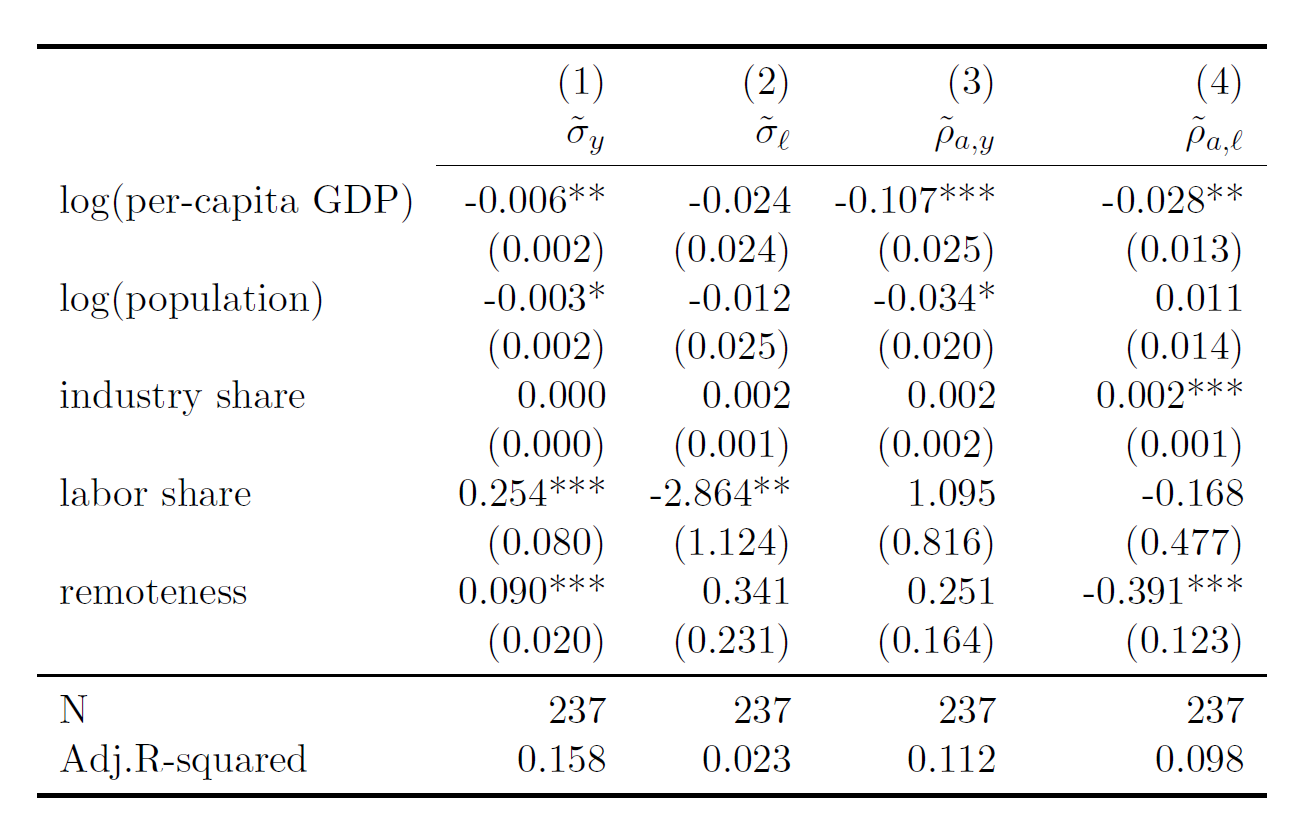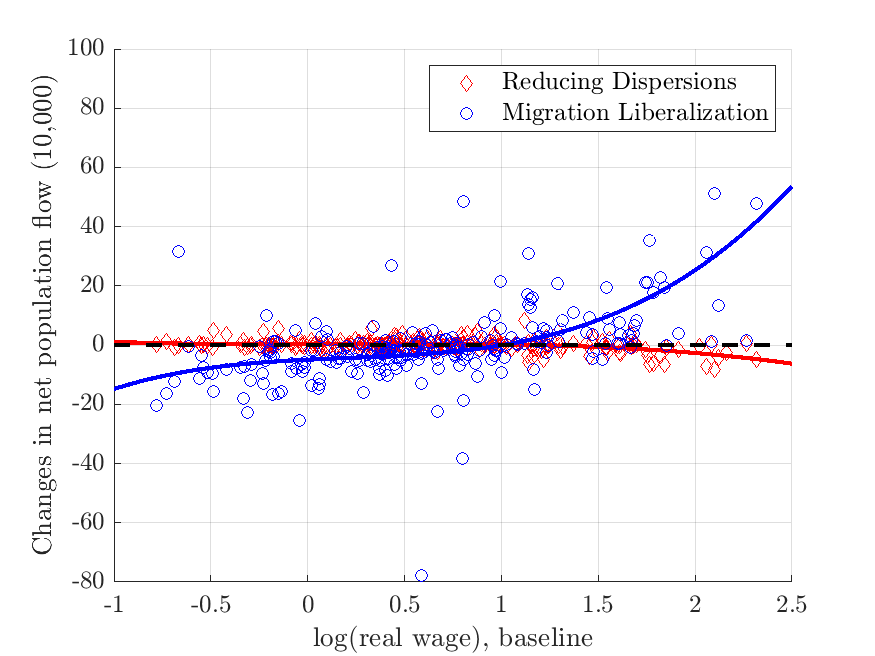Migration and Resource Misallocation in China
Firm-level frictions—the inefficiencies that firms face in input and output markets—could weigh down aggregate productivity and lead to substantial spatial income disparities. We design an empirical strategy to estimate the joint distribution of productivity and frictions across prefectures in China. We document substantial and meaningful variations in the distribution of firm-level frictions, and show that reducing frictions could improve aggregate output, reduce spatial inequality, and discourage population concentration in large cities.

Regional inequality has long been a focal policy concern for large developing economies. While economic development in some cities and regions has already reached levels similar to those of a high-income economy, other lagged-behind locations could have significantly lower levels of development. What factors could contribute to spatial disparity, and what are the possible policy remedies to close the spatial gap? These are the questions that researchers and policymakers seek answers to around the world.
The economic literature has documented that the frictions that firms face—the additional costs and inefficiencies in either purchasing inputs or selling outputs—are substantial and could contribute to the productivity gap between developing and developed economies (e.g., Restuccia and Rogerson 2008; Hsieh and Klenow 2009; Buera, Kaboski, and Shin 2011; Midrigan and Xu 2014). For example, while some firms might receive favorable treatment in the product market due to better connections with government officials, other less-connected and less-favored firms might face discrimination in the same market. The uneven distribution of frictions across firms leads to resource misallocation that damages productivity and welfare. These frictions are often rooted in differences in institutional quality, geography, and infrastructure investment across countries. However, the same underlying factors may also vary across regions within the country, thus contributing to spatial inequality. More importantly, workers migrate within the country, and therefore, policies that aim to reduce firm-level frictions in one region may exert spillover effects on other regions through labor mobility. This observation also leads to an interesting policy question: if a policy aims to reduce inequality across workers in different locations, should it focus on 1) reducing resource misallocation within the less-developed regions or 2) lowering migration costs so the workers can leave the more distorted locations easily?
To answer these questions, we propose a quantitative spatial equilibrium framework to estimate the firm-level frictions in each Chinese prefecture and then quantify their spatial impacts. The model classifies firm-level frictions into two categories: “output friction” is considered a wedge over a firm’s sales revenue, thus affecting its size, while “labor friction” is assumed to be an additional cost on the payroll, thus distorting input decisions. Each firm in the model draws the two frictions together with its productivity from a location-specific joint distribution. The entry and production decisions are then made based on the realization of the draw. Workers in the model endogenously choose a location to work. The decision depends on the real wage in the destination city, the migration cost between the origin and destination city, and an idiosyncratic preference shock toward each city.
The model allows many channels through which firm-level frictions matter economically: (1) within a firm, the frictions affect the firm’s decisions in both input and output markets; (2) within a region, those firm-level decisions are aggregated to affect local wage and price index; (3) across regions, the impacts on one region are transmitted to others through interregional trade, as the production in each region requires intermediate inputs from all the other regions; (4) and in terms of labor mobility, those aforementioned impacts may be amplified as workers prefer to work in locations with higher real wages.
The model delivers structural equations that allow one to back out the joint distribution of frictions and productivity from observed firm-level data. Separately identifying frictions from productivity within a firm has always been an empirical challenge in the literature due to correlation between the two, and the survival bias—we only observe the firms with better productivity, lesser frictions, or both in the data. We met these challenges with a model-based estimation approach. We model firm entry and exit conditional on productivity and frictions, and therefore directly accounting for selection bias. We then rely on simulated methods of moments to infer the parameters governing the joint distribution of frictions and productivity, matching the firm size distribution and the correlation between firm size and frictions measured in the data.
Several interesting patterns emerge from our estimation results. First, both output and labor frictions prevail in all Chinese cities, indicating substantial welfare gains from policies at further market reforms. Second, labor markets are more distorted than output markets: the average standard deviation of labor frictions is roughly one order of magnitude larger than that of the output friction. The glaring inefficiencies in the input market highlight that policies aimed at the input instead of the output ends could be more effective. Lastly, locations with higher dispersion of friction also tend to see higher correlations between friction and productivity. This pattern is particularly damaging, as highly distorted locations also discriminate against more productive firms.
We also observe systematic variations of resource misallocation across regions, as shown in Table 1. On average, locations with higher per-capita GDP tend to experience less dispersion in firm-level frictions, so resource misallocation is less severe. Moreover, resource misallocation is less correlated with firm-productivity productivity correlation. For example, while the median dispersion of the output frictions is around 0.085 in the wealthier regions of China along the southern and eastern coasts , the same statistics are 0.108 for the poorer and inland regions. The correlations between output friction and productivity are closer to zero along the coasts and much higher, around 0.24, in the poorer areas.
Table 1 : Covariates of Frictions
We use the model to assess the impact of resource misallocation in the early 21st-century Chinese economy with counterfactual simulations. First, we lower the degree of resource misallocation within all cities by reducing the standard deviations in both output and labor frictions. Reducing misallocation substantially increases aggregate welfare. For example, reducing the standard deviation of the output friction distribution by 0.01, or roughly one-tenth of the national average, increases aggregate welfare by 1.2%—equivalent to a semi-elasticity of 1.2; reducing the misallocation in the input market has a slightly higher impact with a semi-elasticity of 1.9. Reducing misallocation is effective because in a world with less distortive frictions, firm size distributions rely more on their productivity, and resources such as labor and materials are allocated more efficiently across firms by market forces. In addition, with labor mobility, the reduction in misallocation also encourages migration toward smaller prefectures and alleviates the congestion disutility in megacities. Lastly, redistributing the population toward smaller and less developed locations also reduces spatial inequality because these locations tend to benefit more from the reduction due to their high initial levels of distortion.
Which policy is more effective at reducing spatial inequality? We also compare place-based policies that reduce local friction and those that lower the migration barrier. We simulate two policies that achieve the same level of aggregate gain in welfare and compare their differential impacts across locations. We find that the two policies have strikingly different predictions for spatial inequality. When migration costs are lowered, people move to the richer prefectures. When the distortions are less dispersed, the initially poor locations see larger improvements in real wage, and therefore drawing in population , as seen in Figure 1. As a result, the Gini coefficient of real wage increases with migration liberalization by 0.002 and decreases under less dispersed microlevel distortions by 0.001.
Figure 1: : Comparing Policies
In conclusion, our work shows that both output and labor frictions prevail and vary significantly across cities. Output frictions are less dispersed and correlated with productivity in richer prefectures. The quantitative results reveal gains in aggregate welfare and lower spatial income inequality from reducing friction dispersions. In addition, we show that labor mobility dampens the welfare loss led by firm-level frictions, but simultaneously worsens spatial inequality.
References
Buera, Francisco J., Joseph P. Kaboski, and Yongseok Shin. 2011.“Finance and Development: A Tale of Two Sectors.” American Economic Review 101 (5): 1964–2002. https://doi.org/10.1257/aer.101.5.1964.
Hsieh, Chang-Tai, and Peter J. Klenow. 2009. “Misallocation and Manufacturing TFP in China and India.” Quarterly Journal of Economics 124 (4): 1403–48. https://doi.org/10.1162/qjec.2009.124.4.1403.
Li, Xiaolu, Lin Ma, and Yang Tang. 2024. “Migration and Resource Misallocation in China.” Journal of Development Economics 167: 103218. https://doi.org/10.1016/j.jdeveco.2023.103218.
Midrigan, Virgiliu, and Daniel Yi Xu. 2014. “Finance and Misallocation: Evidence from Plant-Level Data.” American Economic Review 104 (2): 422–58. https://doi.org/10.1257/aer.104.2.422.
Restuccia, Diego, and Richard Rogerson. 2008. “Policy Distortions and Aggregate Productivity with Heterogeneous Establishments.” Review of Economic Dynamics 11 (4): 707–20. https://doi.org/10.1016/j.red.2008.05.002.

Latest
Most Popular
- VoxChina Covid-19 Forum (Second Edition): China’s Post-Lockdown Economic Recovery VoxChina, Apr 18, 2020
- China’s Great Housing Boom Kaiji Chen, Yi Wen, Oct 11, 2017
- China’s Joint Venture Policy and the International Transfer of Technology Kun Jiang, Wolfgang Keller, Larry D. Qiu, William Ridley, Feb 06, 2019
- The Dark Side of the Chinese Fiscal Stimulus: Evidence from Local Government Debt Yi Huang, Marco Pagano, Ugo Panizza, Jun 28, 2017
- Wealth Redistribution in the Chinese Stock Market: the Role of Bubbles and Crashes Li An, Jiangze Bian, Dong Lou, Donghui Shi, Jul 01, 2020
- What Is Special about China’s Housing Boom? Edward L. Glaeser, Wei Huang, Yueran Ma, Andrei Shleifer, Jun 20, 2017
- Evaluating Risk across Chinese Housing Markets Yongheng Deng, Joseph Gyourko, Jing Wu, Aug 02, 2017
- Privatization and Productivity in China Yuyu Chen, Mitsuru Igami, Masayuki Sawada, Mo Xiao, Jan 31, 2018
- How did China Move Up the Global Value Chains? Hiau Looi Kee, Heiwai Tang, Aug 30, 2017
- China’s Shadow Banking Sector: Wealth Management Products and Issuing Banks Viral V. Acharya, Jun Qian, Zhishu Yang, Aug 09, 2017




 Facebook
Facebook  Twitter
Twitter  Instagram
Instagram WeChat
WeChat  Email
Email 




